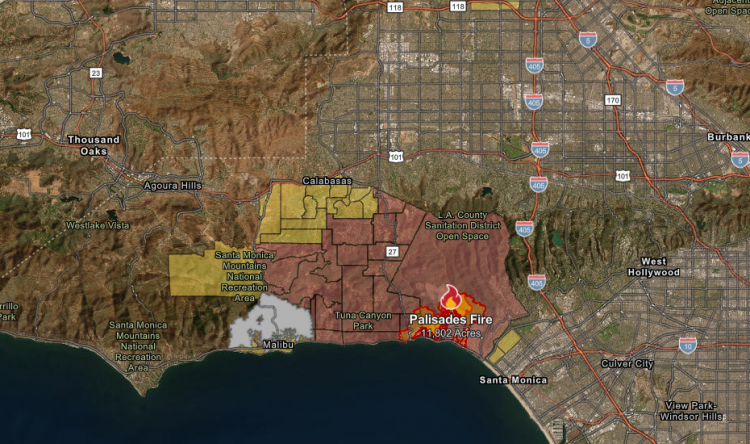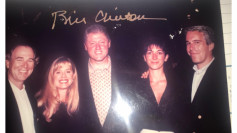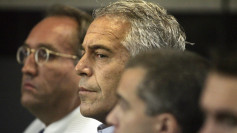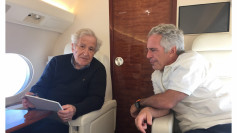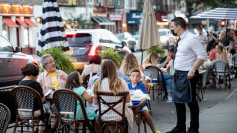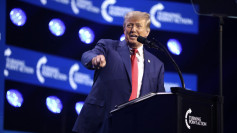Wildfires swept through Los Angeles County on Wednesday, killing at least two people, injuring dozens, and destroying more than 1,000 structures as firefighters battled blazes fueled by extreme winds and dry conditions. The fires forced the evacuation of more than 70,000 residents, including celebrities and local officials, as flames threatened affluent neighborhoods and critical infrastructure.
Three major fires-the Eaton Fire, the Palisades Fire, and the Hurst Fire-burned across the region from the Pacific Coast to Pasadena. High winds, including gusts exceeding 100 mph, grounded firefighting aircraft for much of the night, allowing flames to spread rapidly across densely populated areas.
"This morning, we woke up to a dark cloud over all of Los Angeles," said L.A. County Supervisor Lindsey Horvath. "But it is darkest for those who are most intimately impacted by these fires. It has been an immensely painful 24 hours."
The Eaton Fire, which ignited Tuesday evening near Altadena, quickly consumed 10,000 acres, killing two people and destroying over 100 structures, according to L.A. County Fire Chief Anthony Marrone. Meanwhile, the Palisades Fire scorched 5,000 acres, jumping Pacific Coast Highway and engulfing multimillion-dollar homes along the iconic stretch. More than 1,000 structures have been lost in the Palisades area alone.
The Hurst Fire, burning in Sylmar, had spread to 500 acres by Wednesday morning. Fire officials reported "significant injuries" among residents who failed to evacuate in time, as well as first responders working the fire lines.
California Governor Gavin Newsom deployed 1,400 firefighting personnel to combat the blazes, describing the situation as "all hands on deck." On X (formerly Twitter), Newsom assured residents that emergency responders were working through the night to protect lives and property.
Wind gusts of up to 99 mph, fueled by the notorious Santa Ana winds, hindered firefighting efforts. The National Weather Service warned of a "life-threatening, destructive, and widespread windstorm" that would continue through Thursday. Meteorologist Rich Thompson called the event the strongest windstorm to hit the region since 2011, when a similar event caused $40 million in damage in Pasadena and Altadena.
The fires prompted mass evacuations across Los Angeles County. Hollywood stars, including Mark Hamill and Mandy Moore, were among those forced to flee. Vice President Kamala Harris's Los Angeles home was also in an evacuation zone, though no one was present at the time, according to her office.
Traffic jams plagued evacuation routes as thousands of residents fled the flames. In Pacific Palisades, abandoned cars blocked key roads, requiring bulldozers to clear paths for emergency vehicles. "People were getting out of the cars with their dogs and babies and bags," said resident Kelsey Trainor. "They were crying and screaming."
The wildfires left a trail of devastation. Entire neighborhoods were reduced to ash, and iconic landmarks like Sunset Boulevard and Palisades Charter High School suffered significant damage. More than 180,000 residents lost power due to the fires, with Southern California Edison warning that over 500,000 could face outages if conditions worsen.
Longtime Palisades resident Will Adams described the chaos as embers flew into his wife's car during their evacuation. "She vacated her car and left it running," he said. "It is crazy, it's everywhere, in all the nooks and crannies of the Palisades."
The lack of rainfall in Southern California has exacerbated the fire season, which typically ends by October. Since October 1, downtown Los Angeles has received only 0.16 inches of rain, far below the average of 4.64 inches for this time of year. By contrast, Northern California has experienced above-average rainfall.
Experts attribute the extended fire season to climate change, which has led to rising temperatures and delayed rains. "Southern California has experienced a particularly hot summer, followed by almost no precipitation during what is normally our wet season," said Alex Hall, director of the UCLA Center for Climate Science. "And all of this comes on the heels of two very rainy years, which means there is plenty of fuel for potential wildfires."
As firefighters work to contain the blazes, officials urged residents to remain vigilant. "These are unprecedented conditions, but also unpredictable," said L.A. Police Chief Jim McDonnell. "As the fires continue to spread and pop up in different locations, none of us know where the next one is going to be."
